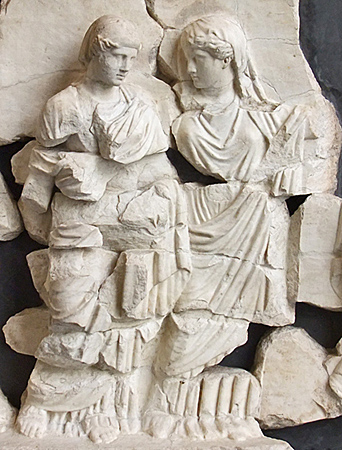
Marble relief of a Sabine bride with Hersilia
Fragment of the Basilica Aemilia frieze, 1st century BCE-CE

Hersilia, a legendary figure who belongs to the earliest period of Roman history, is remembered for preserving the young city from its hostile neighbors through persuasion for the common good. Livy celebrates this first Roman coniunx, probably a Sabine by birth, as a positive exemplum in Book 1.11, a chapter which she shares with her negative female counterpart, the virgo Tarpeia.
While ancient sources offer differing accounts of how Hersilia came to be among the maidens who attended that fateful celebration of the Consualia in Rome from neighboring Caenina, Crustumerium, Fidenae, Antemnae and the Sabine settlement on the Quirinal Hill, almost all agree that she was a married woman at the time. They differ, however, as to the identity of her husband: for Livy (see below), Ovid (Metamorphoses 14.829-51, Fasti 3.206) and Silius Italicus (Punica 13.811-15), it is Romulus; Dionysius of Halicarnassus (3.1) notes that it was Hostilius, as does Macrobius (Saturnalia 1. 6. 16), who further declares that, taken in error while protecting her maiden daughter, Hersilia was given by Romulus to Hostus Hostilius, a Latin refugee, to marry; Plutarch (Romulus 14.7) observes that some say it was Hostilius, others Romulus. Most sources assert that she had a daughter, Prima; Dio (56.5.5, quoting Augustus) records that Hersilia attended her daughter at her wedding. Some say that Hersilia had a son as well, named Hostus or Avillius, fathered respectively by Hostilius or Romulus. What all agree to a greater or lesser degree is that, using her powers of persuasion, she led the captive neighboring women to advance the ideal of concordia, symbolized by marriage, over military conquest (see Plutarch Romulus 19, Dionysius of Halicarnassus 2.45-46). Hersilia was not only the mediator for reconciliation between the women and their captors, but also between the Sabines and the Romans. The goddess Concordia (literally, the “joining of hearts”) represented both a Roman marital ideal and also a paradigm of political unity. How appropriate, then, that after the death of Romulus and his deification as Quirinus, Hersilia was granted divine status as the goddess Hora Quirini (see Ovid and Silius).
The image on the left is a detail from the surviving fragments (a total of 22 meters) of the Pentelic marble frieze (thought to have been originally 184 meters long) depicting scenes from Rome's legendary founding and early history that may have once encircled the lower entablature of the interior nave of the Basilica Aemilia (constructed 179 BCE) in the Roman Forum. Most scholars date the frieze on stylistic grounds to the building's restoration in 55-34 BCE by L. Aemilius Paulus and his son. This frame is considered to be a representation of the Sabine brides at their Roman wedding. The woman on the right, apparently a matrona (note her stola), is thought to be Hersilia, assisting one (perhaps her daughter Prima) of the group of captive maidens (see timed reconstruction drawing). The scene immediately contiguous to it is that of the Punishment of Tarpeia (see timed reconstruction drawing), reflecting the sequence of events in Livy's narrative. For more information, consult: Wiseman's article in the Bibliography; Fr. C. Albertson's article "The Basilica Aemilia Frieze" (Latomus 49 (1990): 801-15); the webpage Matrimonium; the site Basilica Aemilia/Basilica Paulli on VRoma.
(1) Dum ea ibi Romani gerunt, Antemnatium exercitus per occasionem ac solitudinem hostiliter
![]()
in fines Romanos incursionem facit. Raptim et ad hos Romana
![]() legio ducta palatos in agris oppressit.
legio ducta palatos in agris oppressit.
(2) Fusi igitur primo impetu et clamore hostes, oppidum captum; duplicique victoria ovantem
Romulum Hersilia coniunx, precibus raptarum fatigata, orat ut parentibus earum det veniam et
in civitatem accipiat: ita rem coalescere concordia
![]()
![]() posse. Facile impetratum.
posse. Facile impetratum.
Click on the underlined words for translation aids and commentary, which will appear in a small window. Click on the icon link![]() to the right of the line for related images and information.
to the right of the line for related images and information.